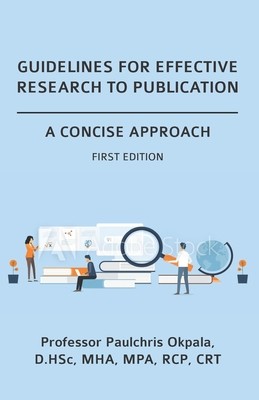
- We will send in 10–14 business days.
- Author: Paulchris Okpala
- Publisher: Steuben Press
- ISBN-10: 1950724735
- ISBN-13: 9781950724734
- Format: 14 x 21.6 x 1 cm, softcover
- Language: English
- SAVE -10% with code: EXTRA
Guidelines for Effective Research to Publication (e-book) (used book) | bookbook.eu
Reviews
Description
This book aims to guide students and novice researchers on ways of carrying out effective research and writing a publishable manuscript. The first part of the text documents the important feature of quality research. The text provides concise guidelines on how to develop publishable research by describing the key features of the title and the various approaches that should be used in the development of the title. The text also describes the statement of the problem and the features of a well-framed statement of the problem. The text also describes the formulation of an effective research question and the common errors that researchers should avoid. The important aspects of the conceptual and theoretical frameworks are also described, along with the criteria that researchers should use in the development of the conceptual or theoretical framework. The important features of the literature review, methodology, description of the findings, and the abstract are also discussed. Each chapter in the first part of the text concludes with a checklist for the assessment of the individual section.The second part of the book provides guidelines on the selection and packaging of the manuscript. It describes when and how to identify the appropriate journal. Also, it highlights the steps that should be taken to achieve clarity in writing, enhance the relevance, and avoid plagiarism. The author also discusses communication with editors, with an emphasis on how to address the rejection of the manuscript. Finally, the text describes how researchers can ensure effective time management .The author suggests that researchers who will be using this text as a guide in their research should first consider reading Chapter 12 on time-saving strategies. The chapter enables researchers to effectively plan their work to ensure timely submission of the manuscript. The reader can then read the first eight chapters then proceed to Chapter 9. Chapter 9 enables the readers to select a journal and read the journal's instructions, which provide additional instructions on how to design the methodology, write the results, and provide the discussion.
EXTRA 10 % discount with code: EXTRA
The promotion ends in 19d.20:32:21
The discount code is valid when purchasing from 10 €. Discounts do not stack.
- Author: Paulchris Okpala
- Publisher: Steuben Press
- ISBN-10: 1950724735
- ISBN-13: 9781950724734
- Format: 14 x 21.6 x 1 cm, softcover
- Language: English English
This book aims to guide students and novice researchers on ways of carrying out effective research and writing a publishable manuscript. The first part of the text documents the important feature of quality research. The text provides concise guidelines on how to develop publishable research by describing the key features of the title and the various approaches that should be used in the development of the title. The text also describes the statement of the problem and the features of a well-framed statement of the problem. The text also describes the formulation of an effective research question and the common errors that researchers should avoid. The important aspects of the conceptual and theoretical frameworks are also described, along with the criteria that researchers should use in the development of the conceptual or theoretical framework. The important features of the literature review, methodology, description of the findings, and the abstract are also discussed. Each chapter in the first part of the text concludes with a checklist for the assessment of the individual section.The second part of the book provides guidelines on the selection and packaging of the manuscript. It describes when and how to identify the appropriate journal. Also, it highlights the steps that should be taken to achieve clarity in writing, enhance the relevance, and avoid plagiarism. The author also discusses communication with editors, with an emphasis on how to address the rejection of the manuscript. Finally, the text describes how researchers can ensure effective time management .The author suggests that researchers who will be using this text as a guide in their research should first consider reading Chapter 12 on time-saving strategies. The chapter enables researchers to effectively plan their work to ensure timely submission of the manuscript. The reader can then read the first eight chapters then proceed to Chapter 9. Chapter 9 enables the readers to select a journal and read the journal's instructions, which provide additional instructions on how to design the methodology, write the results, and provide the discussion.


Reviews